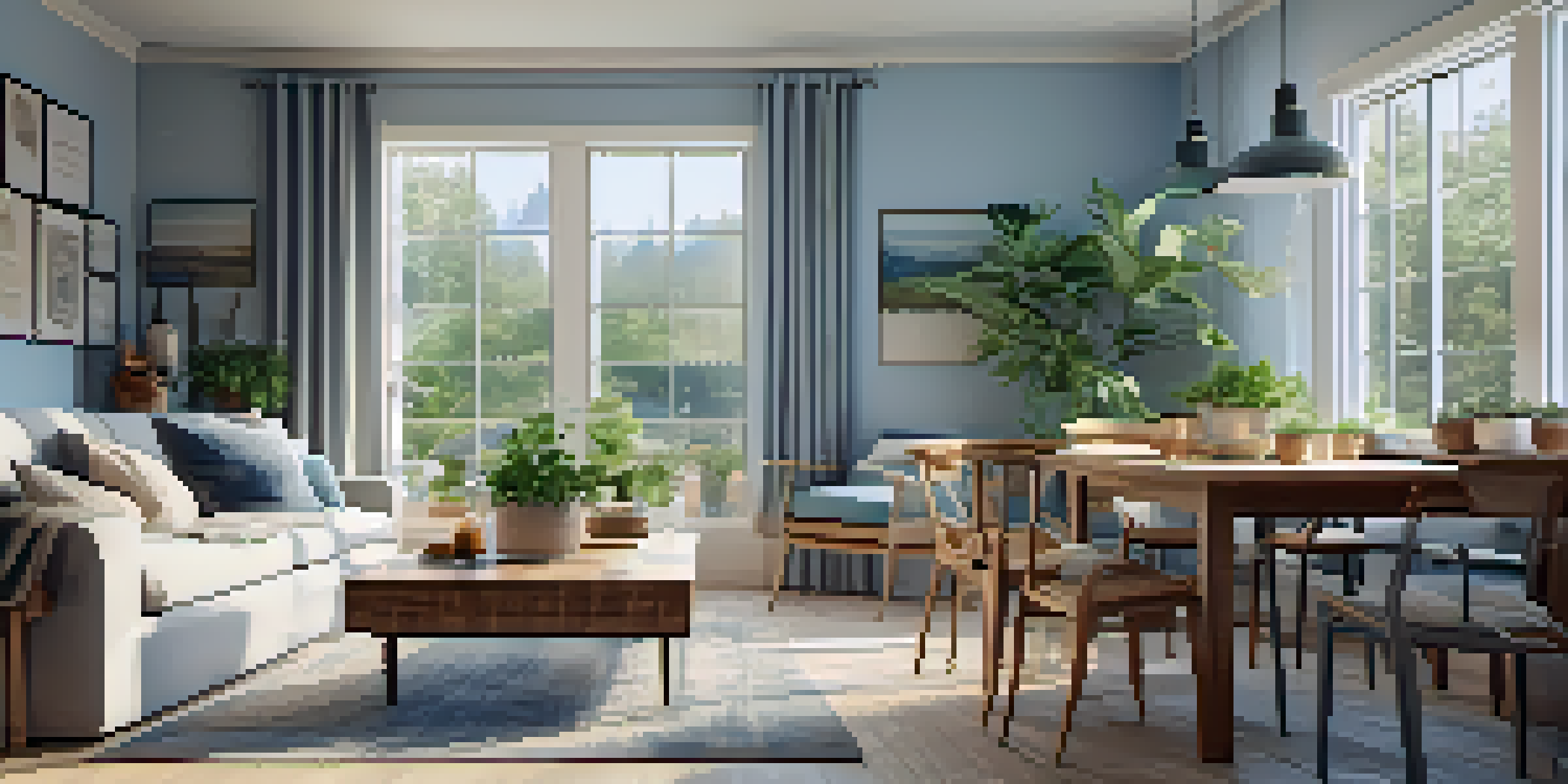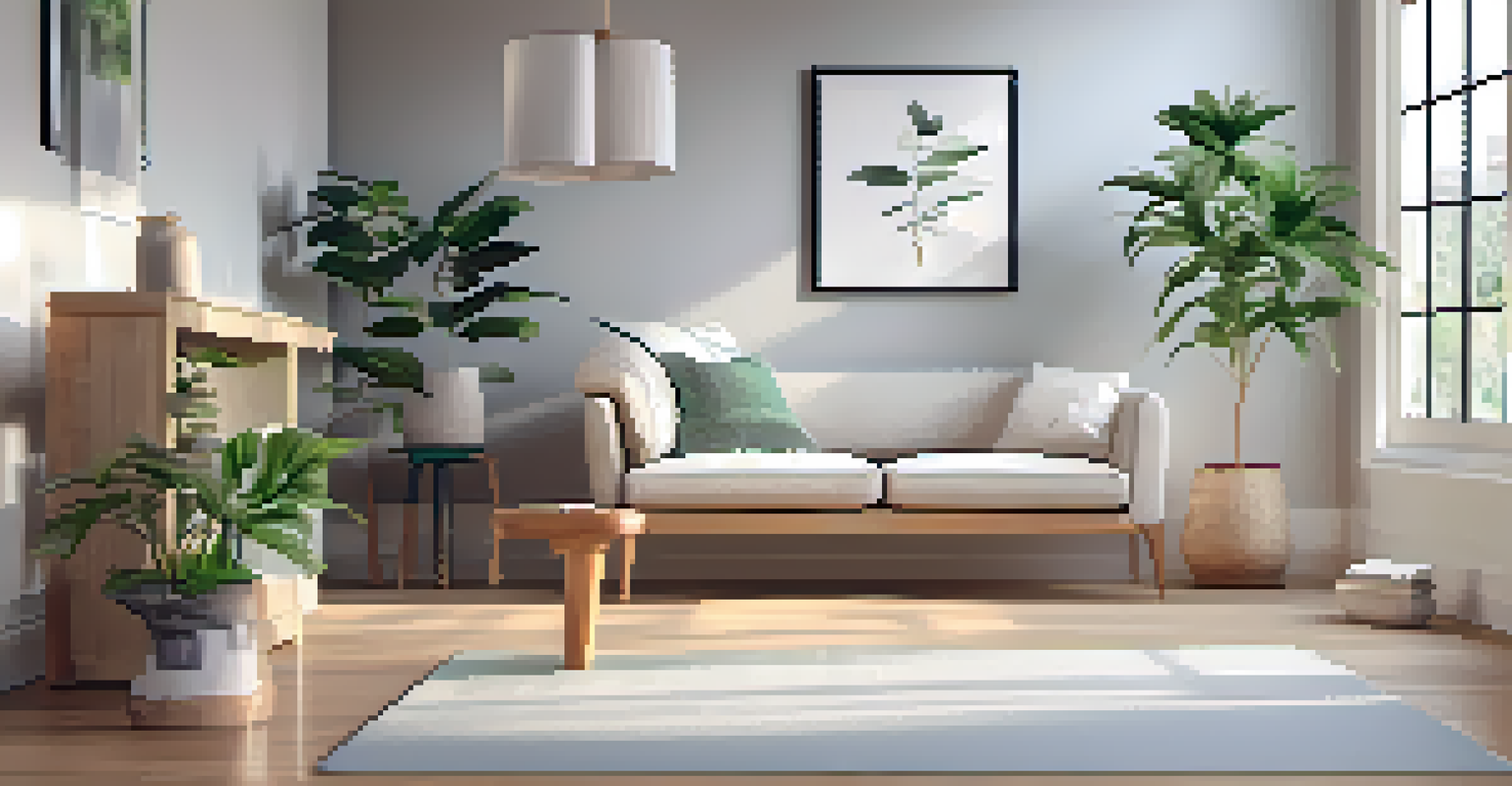Open Concept Living: A Path to Mindful Living

Understanding Open Concept Living and Its Appeal
Open concept living is a design trend that emphasizes spaciousness by removing walls between common areas like the kitchen, dining, and living room. This layout creates a seamless flow, allowing people to engage with one another more easily. The appeal lies in its ability to encourage interaction, making gatherings feel more inclusive and communal.
The best way to predict the future is to create it.
Imagine hosting a dinner party where you can cook while still chatting with your guests in the next room. This design not only fosters connection but also allows natural light to flow throughout the space, creating a bright and inviting atmosphere. By breaking down barriers, open concept living can transform the way you experience your home.
Moreover, this layout can lead to a more organized and peaceful environment. With fewer walls and divisions, it encourages a minimalist approach to decor, reducing clutter and distractions. Ultimately, open concept living isn't just about aesthetics; it’s about cultivating an atmosphere that promotes mindfulness and presence.
Mindfulness Through Space: The Psychological Benefits
Living in an open concept space can significantly impact your mental well-being. The freedom of movement and visibility can reduce feelings of confinement, which in turn can lower stress levels. This design invites a sense of calm, as you’re less likely to feel overwhelmed by walls that create a sense of separation.

For example, when you can see your children playing in the living area while cooking, you can feel more connected and engaged in their activities. This visibility allows for better supervision and interaction, fostering stronger family bonds. The ability to multitask without feeling pulled apart is a key benefit of this layout.
Mindfulness Enhances Well-Being
Living in open spaces can reduce stress and promote a sense of calm, positively impacting mental health.
Additionally, open spaces can encourage mindful practices such as yoga and meditation, as they provide a tranquil environment free from distractions. You can create a serene corner in your living area, promoting a lifestyle that values peace and presence. By embracing open concept living, you’re not just rearranging furniture; you’re setting the stage for a more mindful way of life.
Designing Your Open Concept Space Mindfully
Creating a mindful open concept space involves thoughtful design choices that enhance both aesthetics and functionality. Start by selecting a color palette that promotes tranquility, such as soft blues or earthy tones. These colors can create a calming atmosphere that encourages relaxation and focus.
Simplicity is the ultimate sophistication.
Incorporate natural elements like wood and plants to bring the outdoors inside. Biophilic design, which emphasizes our connection to nature, can improve mood and well-being. Adding greenery not only purifies the air but also adds life and vibrancy to your open space, making it feel more inviting.
Finally, consider the flow of movement within your space. Arrange furniture to encourage conversation and interaction, creating cozy nooks for relaxation while maintaining openness. The goal is to create a harmonious environment that supports mindfulness and fosters connections among family and friends.
Incorporating Mindful Practices in Daily Life
Living mindfully in an open concept space goes beyond design; it’s about integrating practices into your daily life. Start by setting aside dedicated time for activities such as meditation or journaling in your serene corner. This helps you cultivate a routine that prioritizes your mental health amidst the busyness of everyday life.
You can also practice mindfulness during social interactions. For instance, when hosting friends, leave your phones in another room to encourage genuine conversation. This simple act of being present with one another promotes deeper connections and enhances the overall experience of togetherness.
Fostering Connection Through Design
Open concept living encourages interaction and inclusivity, transforming gatherings into more engaging experiences.
Finally, consider meal times as an opportunity for mindfulness. Cooking together in your open kitchen not only fosters collaboration but also encourages you to appreciate the process of preparing food. Eating together as a family in a shared space can turn mealtime into a cherished ritual that strengthens bonds and promotes mindfulness.
The Impact of Open Concept Living on Family Dynamics
Open concept living can significantly enhance family dynamics by promoting togetherness and communication. With everyone in a shared space, it becomes easier to engage in conversations and share activities, from cooking to playing games. This environment fosters a strong sense of community within the family unit.
For instance, imagine a family cooking dinner together, each person contributing to the meal while sharing stories and laughter. This collaborative approach not only makes cooking more enjoyable but also strengthens family relationships. The open layout encourages participation and teamwork, making it easier to bond over shared experiences.
Moreover, open spaces allow for greater visibility, which can be particularly beneficial for parents who want to keep an eye on their children. This sense of security can lead to a more relaxed atmosphere, allowing everyone to feel comfortable and connected. Ultimately, open concept living nurtures a family environment rooted in love and togetherness.
Embracing Minimalism in Open Concept Living
Open concept living naturally lends itself to a minimalist lifestyle, focusing on what truly matters. By reducing clutter and excess, you create a serene environment that promotes mindfulness. The principle of 'less is more' becomes evident as you curate your belongings, keeping only those items that bring you joy or serve a purpose.
Consider adopting a decluttering routine, where you regularly assess your space and remove items that no longer serve you. This practice not only frees up physical space but also clears mental clutter, allowing you to focus on what’s important. A minimalist approach can transform your home into a sanctuary of calm and clarity.
Minimalism for a Serene Environment
Embracing minimalism in open concept spaces creates a tranquil atmosphere that encourages mindfulness and intentional living.
Furthermore, minimalism encourages intentionality in your purchases. When you choose to invest in quality over quantity, you create a meaningful living environment that reflects your values. This alignment between your space and your lifestyle fosters a deeper sense of peace and mindfulness in your everyday life.
Conclusion: A Mindful Journey Through Open Concept Living
In conclusion, open concept living offers a unique opportunity to embrace mindfulness in our daily lives. By designing spaces that encourage engagement and interaction, we create environments that foster connection and well-being. This lifestyle shift invites us to be present, turning our homes into sanctuaries of peace.
As you explore the possibilities of open concept living, remember that it’s not just about aesthetics; it’s about cultivating a way of life that values presence and connection. By integrating mindful practices into your daily routine, you can enhance the benefits of this living arrangement, promoting a holistic approach to well-being.

Ultimately, open concept living is a journey towards a more mindful existence. As you navigate this path, embrace the changes and cherish the moments of connection, both with yourself and those around you. Your home can become a reflection of your values, nurturing a lifestyle filled with intention and joy.